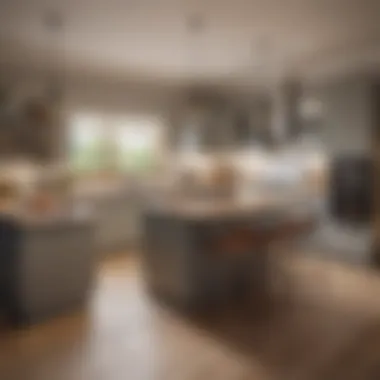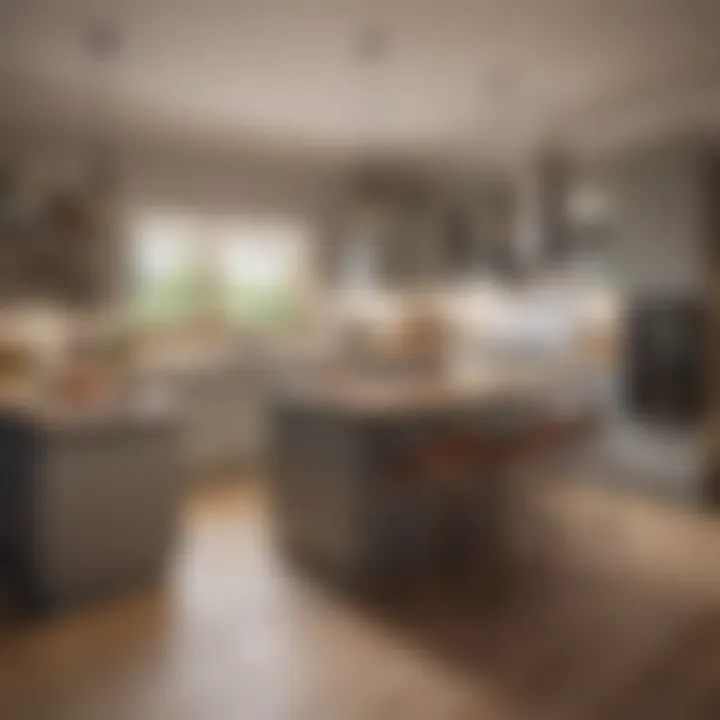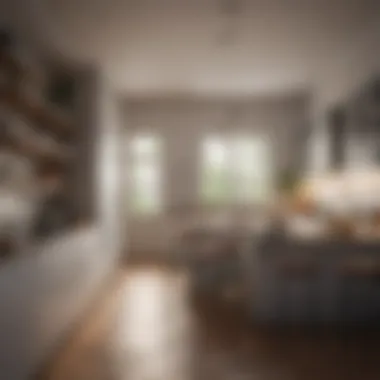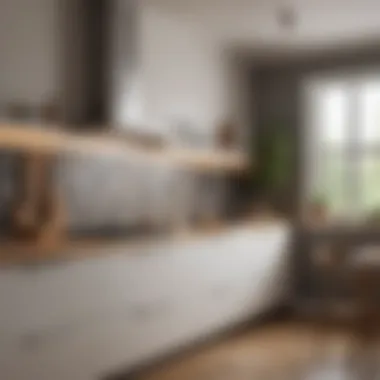Key Elements of Kitchen Layout Diagrams Explained


Intro
Designing a kitchen effectively requires more than aesthetic appeal. It centers on the relationship between space, functionality, and user experience. An optimal kitchen layout diagram serves as a blueprint, illustrating how every component interacts. When homeowners and designers consider layout options, they must think critically about elements such as workflow and ergonomics. This article delves into these essential considerations, guiding you through various layout types and the principles that underpin effective kitchen design.
Design Inspiration
A well thinked kitchen environment can inspire creativity and facilitate daily activities. The layout is not only about placing appliances but also about creating a harmonious space that reflects personal style.
Trending Styles
In recent years, several kitchen styles have gained prominence. These styles include:
- Open Concept: Merging kitchen space with dining and living areas emphasizes social interaction.
- Industrial: This style features raw materials, such as metal and wood, with a focus on functionality.
- Minimalist: Clean lines and a clutter-free aesthetic characterize minimalist kitchens.
- Farmhouse: This invites warmth with rustic finishes, blending modern convenience with traditional charm.
Each style offers unique advantages, yet they must align with personal preferences and the existing structure of the home.
Color Palettes
Colors play a pivotal role in setting the mood of the kitchen. A carefully chosen palette enhances the visual appeal. Consider the following popular color schemes:
- White and Gray: Timeless and versatile, this combination brings brightness and a sense of spaciousness.
- Bold Colors: Shades like navy blue or emerald green can inject drama and personality into a kitchen.
- Earth Tones: Using browns, greens, and terracotta can create a calming atmosphere that feels connected to nature.
Selecting the right colors involves considering the overall theme and the natural light available in the space.
"The kitchen is often considered the heart of the home, making its design essential for comfort and efficiency."
Practical Tips
Being mindful of practical aspects can ease the design process, leading to a functional kitchen that meets all needs.
Maintenance & Care
Ensuring that the kitchen remains beautiful requires routine maintenance. To maintain surfaces and appliances:
- Regularly clean countertops using non-abrasive cleaners to prevent wear.
- For stainless steel appliances, use appropriate cleaners to avoid scratches.
- Air out the kitchen often to avoid moisture buildup, which can lead to mold and odors.
Budgeting & Planning
A clear budget helps manage costs effectively. Here are some tips:
- Prioritize spending according to essential areas like cabinetry and appliances.
- Research before purchasing products to compare prices and quality.
- Plan for unforeseen expenses by setting aside a contingency fund of 10-15% of your budget.
In essence, understanding the key elements of kitchen layout diagrams can transform one’s space into an efficient and comforting environment.
Prelude to Kitchen Layout Diagrams
The role of kitchen layout diagrams cannot be overstated in modern kitchen design. These diagrams serve as the foundation for creating functional and aesthetically pleasing kitchens. A well-executed kitchen layout can significantly enhance the efficiency of the space, making daily activities smoother and more enjoyable. The configuration of a kitchen influences not only the workflow but also the usage of space.
Importance of Kitchen Layout
The blueprint of a kitchen dictates how effectively the cook can operate within the space. A poorly designed kitchen can lead to frustration and inefficient use of time. Conversely, a carefully planned kitchen layout can streamline tasks such as food preparation, cooking, and cleanup. This is especially important in households where multiple people may be using the kitchen simultaneously. A space designed with consideration for movement, accessibility, and convenience minimizes traffic congestion and promotes a more enjoyable cooking environment.
Kitchen layouts directly impact the aesthetics of the space as well. The arrangement of cabinets, appliances, and seating can create an inviting atmosphere conducive to gatherings. Each layout not only serves functional purposes but also reflects the homeowner's style and preferences. Therefore, understanding the significance of kitchen layout diagrams is essential for anyone looking to create a functional and attractive culinary space.
Overview of Common Layout Types
There are several common kitchen layout types, each providing unique advantages and potential drawbacks. Understanding these layouts allows homeowners and designers to choose the one that best suits their specific needs. Here are a few notable examples:
- Galley Kitchen:
A narrow layout featuring two parallel countertops, promoting efficiency. Ideal for small spaces. - L-Shaped Kitchen:
Utilizes two adjacent walls, providing ample counter space and openness for social interaction. - U-Shaped Kitchen:
Encloses three sides with cabinetry and appliances, offering extensive workspace and storage. - Islands and Peninsulas:
These elements can add extra counter space and enhance the kitchen's functionality, often acting as a social hub. - Open Concept Kitchen Designs:
These layouts integrate the kitchen with adjoining living areas, promoting a seamless flow throughout the home.
Each type has distinct characteristics that cater to various needs and preferences. The choice of layout significantly determines the overall kitchen experience. Understanding these differences will aid in making informed decisions during the design process.
"The layout serves as the blueprint that dictates how well a kitchen functions for its users."
Understanding Kitchen Workflow
Kitchen workflow is a crucial aspect when designing kitchen layouts. It involves evaluating how the space is used efficiently during food preparation, cooking, and cleaning. A well-planned kitchen workflow minimizes unnecessary movements, enhances productivity, and improves the overall kitchen experience.
Understanding kitchen workflow allows homeowners and designers to make informed decisions about layout and design. The goal is to provide a layout that accommodates the natural flow of activities. This ensures that frequently used elements are easily accessible, and the kitchen feels intuitive to navigate.
There are specific elements that play a significant role in optimizing kitchen workflow:
- Functionality: The kitchen should facilitate the completion of tasks with minimal steps. This means keeping tools, ingredients, and appliances where they are most needed.
- Efficiency: Efficient workflow can reduce time spent on tasks like meal preparation and cleanup. A kitchen optimized for workflow can make cooking less of a chore.
- Comfort: A comfortable kitchen encourages more time spent cooking and socializing. A thoughtful layout contributes to a welcoming atmosphere.
- Flexibility: Modern lifestyles often require kitchens to adapt to various needs, from home cooking to entertaining guests. A flexible design allows for adjustments in the kitchen layout to meet changing demands.
"A well-structured workflow is like a roadmap for an exceptional kitchen experience. It guides the user and prevents confusion."
In summary, understanding kitchen workflow is essential. It influences kitchen design decisions that affect usability, enjoyment, and performance. By prioritizing workflow, one can create a kitchen that is not only visually appealing but also functionally superior.


The Work Triangle Concept
The work triangle is a fundamental concept in kitchen design that defines the ideal layout between the three main work areas: the stove, refrigerator, and sink. This triangle forms the basis of movement in the kitchen and dictates how comfortably and efficiently a cook can perform culinary tasks.
An effective work triangle should have the following dimensions:
- Each leg of the triangle should be between 4 and 9 feet, ensuring ease of movement without overcrowding.
- The total perimeter of the triangle should not exceed 26 feet, preventing excessive travel distances that can lead to frustration.
Incorporating the work triangle into kitchen layouts promotes:
- Smooth transitions: Easier access to essential appliances and tools allows the cook to navigate the space effortlessly.
- Reduced congestion: With efficient movement, there is less risk of collisions and clutter in the workspace.
- Task-oriented design: The layout aligns with how food is prepared, cooked, and cleaned up, thereby optimizing workflow.
Zoning Principles in Kitchen Design
Zoning principles in kitchen design involve organizing the kitchen into distinct areas, each serving a specific function. These zones facilitate a systematic workflow by grouping similar activities together. Effective zoning enhances both efficiency and ease of use.
Key zones to consider include:
- Preparation Zone: This area includes countertops for chopping and mixing. Proper positioning of utensils and ingredients is essential.
- Cooking Zone: Housing the stove, pots, and pans, this zone should allow for quick access to food preparation and cooking tools.
- Serving Zone: This is where meals are plated and served. It should be conveniently located to minimize movement during meal service.
- Cleaning Zone: Featuring the sink and dishwasher, this area allows for effective cleanup. Keeping it near the serving zone can streamline the process.
When designing a kitchen, placing these zones logically can greatly minimize the time spent moving from one task to the next. Each zone should be equipped with the necessary tools and supplies, further enhancing efficiency in the kitchen.
Thus, understanding kitchen workflow, the work triangle, and zoning principles significantly influence the design of a practical and user-friendly kitchen layout.
Types of Kitchen Layouts
Understanding the different types of kitchen layouts is vital for creating a functional and efficient space. Each layout possesses unique characteristics that cater to varying cooking styles, user needs, and available space. By examining specific layout types, homeowners and designers can make informed decisions that improve both aesthetic appeal and practical usage.
Different layouts can influence the overall flow of movement in the kitchen, ensuring that routine tasks are comfortable and efficient. This is particularly important in households with multiple users or varying culinary skills. As you will see, considerations such as appliance placement, counter space, and storage solutions differ amongst layouts, offering distinct benefits.
Galley Kitchen
A galley kitchen, often seen in smaller homes or apartments, features two parallel counters with a walkway in between. This layout optimizes space efficiently, making it suitable for cooks who value proximity between work zones. The close placement of the sink, stove, and refrigerator can enhance workflow significantly through minimizing unnecessary movements.
One benefit of this layout is its efficiency in organizing tools and supplies. However, the narrow setup may restrict movement, especially for multiple users. It is crucial to consider storage solutions vertically, such as cabinetry shelving, to maximize usable space and keep counters clear.
L-Shaped Kitchen
The L-shaped kitchen consists of two adjoining walls that form an L shape. This layout offers flexibility in design and allows for a more open environment. Here, the kitchen can blend seamlessly into living spaces, making it ideal for both cooking and entertaining.
An L-shaped kitchen is advantageous for informal dining setups, as it often allows room for a table or an island. This format promotes interaction among users, creating a more lively cooking atmosphere. Additionally, zoning principles come into play, allowing distinct areas for preparation, cooking, and cleaning.
U-Shaped Kitchen
A U-shaped kitchen expands on the L-shape by adding a third wall of cabinetry and appliances. This design provides ample counter space, making it suitable for serious cooks and those who enjoy multi-tasking. The additional wall allows for more storage and enhanced organization of various kitchen tools.
However, careful consideration of appliance placement is vital to avoid crowding. The U-shape can foster an efficient work triangle, but impractical spacing may hinder fluid movement. Homeowners should prioritize functionality without forfeiting aesthetics, perhaps by implementing decorative cabinets or stylish layouts that mirror personal taste.
Islands and Peninsulas
Adding an island or peninsula can dramatically change the dynamic of a kitchen space by introducing additional counter area and storage. An island typically stands independently and can serve multiple purposes, while a peninsula extends from an existing counter and connects to another wall.
Islands are particularly beneficial for creating a social aspect in cooking. They can serve as a breakfast bar or a prep area without cutting kitchen users off from the main areas. Peninsulas can create a natural division between the kitchen and adjacent rooms, maintaining an open concept while still providing functionality.
Open Concept Kitchen Designs
Open concept kitchens dissolve traditional barriers between the cooking area and living spaces, encouraging flow and communication. This layout can lend a feeling of expansiveness, making it ideal for gatherings. Yet, the layout comes with challenges such as noise and aroma management, which must be thoughtfully considered.
When designing an open concept kitchen, it is important to establish clear zones while preserving ease of access. Consider cohesive color schemes and material choices that connect the kitchen with surrounding areas. An understanding of sightlines can help create an inviting space while ensuring the necessary workflow remains uninterrupted.
Key Elements of Effective Kitchen Design
An effective kitchen design goes beyond mere aesthetics; it incorporates function and practicality while addressing the user’s needs. Establishing a well-balanced layout is essential in maximizing both usability and comfort. Key elements of effective kitchen design include storage solutions, counter space, and appliance integration. These factors not only enhance the workflow but also elevate the overall user experience.
Storage Solutions and Accessibility
A kitchen must offer ample storage to maintain order. Clutter can hinder efficiency when preparing meals. Therefore, integrating effective storage solutions is paramount. This can involve various types of cabinets, drawers, or shelving.
When designing storage, consider the following:
- Accessibility: Items that are frequently used should be easy to reach. Position cabinets and drawers at a comfortable height.
- Organization: Utilize pull-out shelves or drawer dividers to keep utensils, pots, and pans sorted. This minimizes time spent searching for items.
- Maximizing Space: Corner cabinets can be tricky. Using lazy Susans or pull-out racks can make use of otherwise wasted space.
These solutions not only increase the storage capacity but also contribute to a seamless kitchen workflow. A well-organized kitchen leads to efficiency.


Counter Space and Surface Area
Sufficient counter space is critical in any kitchen. It serves as the primary area for food preparation, cooking, and even casual dining. Inadequate counter space can lead to frustration during meal prep, resulting in a less enjoyable cooking experience.
Here are notable considerations:
- Surface Material: Choose durable materials like quartz or granite that can withstand daily use while being easy to clean.
- Design Flow: Position countertops near the stove and sink for easier access while cooking.
- Versatility: Include an island or a breakfast bar which can double as additional prep space and casual dining area.
Creating ample counter space alleviates congestion during busy cooking periods. This allows multiple users to collaborate smoothly.
Appliance Placement and Integration
Proper placement of appliances plays a vital role in navigating a kitchen efficiently. Decisions made during the layout phase can significantly influence functionality.
Key points to consider:
- Proximity: Ensure that appliances such as the refrigerator, stove, and sink form a cohesive work triangle. This minimizes unnecessary movement and maximizes productivity.
- Integration: Built-in appliances save space and create a streamlined look. Consider using integrated dishwashers or microvawe ovens that blend seamlessly with cabinetry.
- Ventilation: Place range hoods or venting systems appropriately to maintain air quality. This is particularly crucial for capturing cooking odors and smoke.
By focusing on effective appliance placement, one can enhance the overall kitchen flow, ensuring a practical and functional space.
"Efficiency in the kitchen setup is vital, as cooking should be an enjoyable rather than stressful activity."
Understanding these key elements allows homeowners and design enthusiasts to construct functional yet comfortable kitchens. Prioritizing storage, counter space, and appliance placement leads to optimized layouts that cater to various cooking styles and user needs.
Visualizing Kitchen Layouts
Visualizing kitchen layouts is an essential aspect of modern kitchen design. It ensures that every element, from the placement of appliances to the flow of movement, contributes to both functionality and aesthetic appeal. A well-thought-out visual representation can avoid costly mistakes during renovations or new builds. By sketching diagrams or utilizing design software, designers and homeowners can more effectively communicate ideas and preferences, making the planning process smoother. Visualization also helps in reassessing and adapting to any irregularities in space, ensuring that even the most unconventional kitchen shapes can be optimized.
Sketching Basic Diagrams
Sketching basic diagrams is a fundamental technique in kitchen design. It allows for a preliminary exploration of layout ideas before committing to more expensive digital alternatives. When one sketches, they engage in a tactile process that can prompt creative thinking and facilitate spontaneous changes. Here are key considerations for effective sketching:
- Start Simple: Begin with the basic shape of the kitchen space. Outline walls, doors, and windows to define the area clearly.
- Indicate Key Elements: Mark where essential appliances will be located. This includes the refrigerator, stove, and sink, which should maintain a logical flow.
- Think About Accessibility: Represent the placement of cabinets and storage solutions. Ensure that these elements support easy access for all users.
- Iterate and Explore: Encourage multiple sketches for various configurations. Each representation can spark ideas that improve the overall layout.
In summary, basic sketches serve as an invaluable tool in the initial stages of kitchen layout design, granting insights and enhancing creativity.
Utilizing Design Software
Utilizing design software significantly elevates the kitchen visualization process. Today, numerous applications are available that cater to both professionals and homeowners. These software options provide detailed 3D modeling capabilities, which can illustrate how a finished kitchen will look and function. Some prominent benefits include:
- Precision: Design software allows users to measure spaces accurately, ensuring that every detail fits perfectly.
- Realistic Representations: Users can view virtual designs in three dimensions, offering a true sense of how each element interfaces with the others.
- Customization Options: Most applications offer extensive catalogs of materials, colors, and equipment, enabling tailored designs that reflect individual preferences.
- Simulation of Lighting: Software can provide simulations of natural and artificial light, allowing users to select the best solutions for their kitchens.
Some popular design software includes SketchUp, RoomSketcher, and IKEA’s Kitchen Planner. By leveraging these tools, users can transform their kitchen visions into concrete plans, thus reducing the risk of miscalculations and dissatisfaction during the actual build or renovation process.
"A well-visualized kitchen layout can make the difference between a successful cooking experience and a frustrating one."
Challenges in Kitchen Layout Design
Designing a kitchen can often present unique challenges that require careful consideration. These challenges can significantly impact functionality, aesthetics, and overall user satisfaction. This section explores the specific difficulties related to kitchen layout design, emphasizing two primary aspects: dealing with irregular spaces and accommodating multiple users. Each factor plays a critical role in the success of a kitchen layout and must be addressed to create an optimal cooking environment.
Dealing with Irregular Spaces
Irregular spaces in kitchens frequently occur due to architectural limitations, such as odd angles or non-standard dimensions. These spaces necessitate a flexible approach to design. First, assessing the unique shape of the kitchen is crucial. It may require custom cabinetry or unique furniture placements to maximize the available area. Utilizing modular storage units can be beneficial. These units can adapt to odd corners or recesses, making use of what otherwise would be unusable space.
Moreover, incorporating open shelving and wall-mounted racks can expand storage options while maintaining an airy feel. The color scheme should also be considered; light colors can help make a small, irregular space feel larger and more open.
Additionally, when planning lighting, it is essential to ensure adequate illumination in every part of the kitchen. Focusing on illuminating every work zone can compensate for potential shadowy areas caused by unconventional layouts.
"Effectively addressing irregular spaces can transform a perceived limitation into a design feature."
Accommodating Multiple Users
Designing a kitchen that caters to multiple users can be complex. A functional kitchen often serves not just as a cooking area but also as a space for social interaction. The layout must support simultaneous activities without hindering movement. Adopting zoning principles is crucial. Each zone should serve a distinct purpose and be easily accessible.
Prioritizing space for simultaneous cooking and preparation can enhance workflow. For example, incorporating an island can provide extra counter space while allowing for additional seating. It encourages interaction without getting in the way of those who are preparing meals.
Maintaining sufficient clearances around appliances and work areas is another necessity. A minimum of 36 inches between zones is often recommended to allow for ease of movement. This ensures that users can operate efficiently, even at peak times.
Ultimately, involving all potential users in the design process can reveal personal preferences and needs, leading to a more tailored kitchen design that accommodates everyone's ways of working.
Addressing these challenges in kitchen layout design will ensure a well-balanced and efficient space, providing both function and comfort.
Incorporating Aesthetic Elements


When discussing kitchen layout diagrams, aesthetic elements play a crucial role in achieving a harmonious design. While functionality is often prioritized, aesthetics significantly influence the overall ambiance and user experience of the space. The right combinations of color schemes, textures, and lighting can elevate a kitchen, turning it into a lovely gathering area that reflects personal taste and lifestyle.
Aesthetic considerations can transform a kitchen from a mere cooking area to a welcoming space. Choosing colors that resonate with personal style can influence mood and energy levels. For example, soft blues and greens tend to create a calming environment, while vibrant yellows and reds can stimulate appetite and conversation.
In addition to colors, textures contribute to the kitchen's visual appeal. A mix of materials, such as smooth countertops, rough-hewn wood cabinets, and stainless steel appliances, introduces variety and interest. Moreover, these elements can also enhance the functionality by providing different surface qualities for diverse tasks.
Incorporating aesthetic elements requires careful planning to ensure that style does not overshadow practicality. However, when balanced well, these design features beautify the kitchen and enrich its usability. A well-designed kitchen, visually pleasing yet functional, can significantly enhance the enjoyment of cooking and hosting.
Color Schemes and Textures
Color schemes are pivotal in setting the tone of the kitchen. The colors chosen dictate not only the room's aesthetic but also how spacious or cozy it may feel. Popular color palettes include monochromatic schemes, where different shades of a single color are used, or complementary schemes that bring together contrasting colors.
For instance, a classic white kitchen conveys an air of freshness and cleanliness, while warm earthy tones create a comfortable and inviting atmosphere.
Textures are equally vital; they offer depth and dimension. A glossy finish on cabinets might reflect light and add a modern touch, while matte finishes exude a more subdued and rustic feel. Together, colors and textures contribute to the kitchen's character, making it a personalized space.
"The choice of color can significantly impact how a space is perceived and experienced."
Integrating textures, like matte tiles against sleek countertops, can create visual contrast and promote interest. Moreover, combining textures invokes different sensory experiences, enriching the kitchen as a functional and lively environment.
Lighting Considerations in Layouts
Lighting is another fundamental component that should not be overlooked. A kitchen's layout must accommodate various lighting sources to ensure both functionality and ambiance. Natural light, where achievable, should be maximized, as it enhances the kitchen’s character and energy.
Incorporating task lighting under cabinets provides direct illumination on work surfaces, facilitating easier meal preparation. At the same time, ambient lighting promotes comfort, allowing the space to feel inviting during evening gatherings.
Adding pendant lights can also serve as a stylish focal point above islands or dining areas. They can act as a design statement that complements the kitchen's overall aesthetic. Multilayered lighting that combines task, ambient, and accent can create desired moods for different occasions.
Practical Applications of Kitchen Diagrams
Kitchen diagrams are more than just drawings; they serve as a foundation for effective kitchen design and functionality. Their importance cannot be overstated, especially when it comes to renovation projects and new builds. Understanding how to apply these diagrams practically helps maximize space and enhance user experience. They are essential tools for both professionals and enthusiasts alike.
Renovation Projects
When undertaking a renovation, kitchen diagrams become vital. They provide a clear representation of existing layouts, which helps identify areas for improvement. Homeowners can visualize how changes will impact flow and accessibility. The renovation process typically involves a few key considerations:
- Assessment of Layout Needs: Analyzing how the current layout functions helps pinpoint inefficiencies. It may involve moving appliances or introducing more storage.
- Incorporating Modern Design Principles: Many homeowners wish to blend aesthetic appeal with functionality. Diagrams allow for testing different designs while considering storage and workflow.
- Budget Constraints: Understanding the layout can also assist in budgeting accurately. Knowing where adjustments can be made without high costs is essential for many.
By utilizing a well-thought-out diagram, homeowners can streamline their renovation efforts, ensuring they align with personal needs and potential resale value.
New Kitchen Builds
In situations where a kitchen is being built from scratch, diagrams play a crucial role. They assist in planning everything from space allocation to selecting appropriate materials and appliances. Key aspects of creating a kitchen diagram for new builds include:
- Space Optimization: Effective diagrams allocate space wisely, allowing for the best workflow possible. This involves considering how often different areas will be used and ensuring easy access.
- Future Flexibility: New kitchens should be designed with adaptability in mind. Diagrams can facilitate layouts that accommodate future needs, such as expanding families or evolving cooking styles.
- Integration of Technology: Modern kitchens often embed appliances with smart technology. Diagrams help plan electrical outlets, ensuring that everything has the necessary connectivity.
Creating a new kitchen involves many decisions and details. Kitchen diagrams clarify design intentions, ultimately leading to a successful build.
"A well-crafted kitchen diagram can mediate the space and functionality of the heart of the home, ensuring it serves its purpose for years to come."
In summary, the practical applications of kitchen diagrams are essential. For renovation projects, they allow homeowners to reimagine existing spaces thoughtfully. For new builds, they ensure that planning is thorough and future-ready. Both aspects highlight how diagram usage elevates kitchen design from mere concept to functional reality.
Epilogue and Future Trends
In the realm of kitchen design, the conclusion drawn from the various components of kitchen layout diagrams is twofold. Firstly, a well-structured kitchen layout is not merely an aesthetic choice. It significantly influences functionality and efficiency, making it crucial for both homeowners and designers. Secondly, understanding the evolving trends in kitchen designs informs future planning.
The kitchen has transitioned from a utilitarian space into a multifunctional area that integrates cooking, dining, and socializing. With this evolution, trends focus on maximizing space while enhancing the user experience. Future designs are expected to continue prioritizing not just utility but also comfort and aesthetic appeal. High-quality materials and innovative layouts will play significant roles in this evolutionary trend.
The Evolution of Kitchen Designs
Over the past few decades, kitchen designs have undergone a profound transformation. Initially, kitchens were designed strictly for functionality, often limited in space and creativity. The shift has transcended traditional design principles, now embracing open concepts and versatile layouts.
- Key Milestones in Kitchen Design Evolution:
- 1950s-1970s: Emphasis on efficiency led to the rise of the work triangle.
- 1980s-1990s: Introduction of islands and peninsulas, creating more surface area.
- 2000s-Present: Open concept layouts allow integration of kitchen with living areas, encouraging interaction.
This evolution aligns with cultural shifts towards communal living and entertaining. As people seek kitchens that serve multiple purposes, the design must accommodate these needs without sacrificing efficiency or aesthetic value. The focus is now on seamless integration of technology, storage solutions, and social areas.
Sustainability in Kitchen Design
The increasing awareness of environmental issues has led to a significant emphasis on sustainability in kitchen design. Sustainable practices consider both the materials used and energy efficiency. Incorporating elements like energy-efficient appliances, recycled materials, and eco-friendly design practices can markedly reduce the environmental footprint of kitchen spaces.
- Sustainable Kitchen Practices:
- Use of Recycled Materials: Countertops made from recycled glass or sustainable woods.
- Energy-Efficient Appliances: Models that meet ENERGY STAR standards promote energy conservation.
- Smart Technology: Automation and smart home integration contribute to efficiency and user satisfaction.
Additionally, sustainable kitchen design not only helps in reducing environmental impact but can also provide long-term cost savings. Homeowners become mindful of their choices, realizing that a sustainable kitchen holds considerable value in today’s market.
"A sustainable kitchen design is not just a trend; it's a pathway to smarter living, combining aesthetic beauty with practical responsibility."















